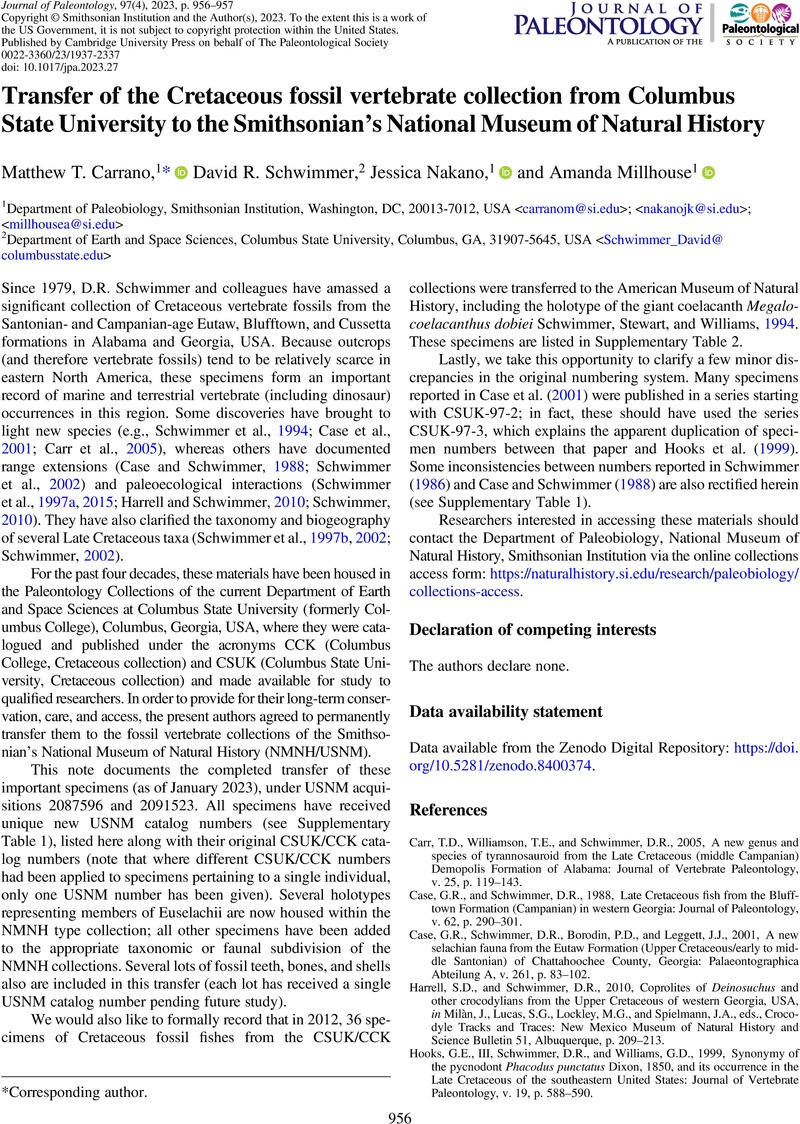No CrossRef data available.
Article contents
Transfer of the Cretaceous fossil vertebrate collection from Columbus State University to the Smithsonian's National Museum of Natural History
Published online by Cambridge University Press: 11 October 2023
Abstract
An abstract is not available for this content so a preview has been provided. Please use the Get access link above for information on how to access this content.

- Type
- Collections Notes
- Information
- Creative Commons
- To the extent this is a work of the US Government, it is not subject to copyright protection within the United States
- Copyright
- Copyright © Smithsonian Institution and the Author(s), 2023. Published by Cambridge University Press on behalf of The Paleontological Society
References
Carr, T.D., Williamson, T.E., and Schwimmer, D.R., 2005, A new genus and species of tyrannosauroid from the Late Cretaceous (middle Campanian) Demopolis Formation of Alabama: Journal of Vertebrate Paleontology, v. 25, p. 119–143.CrossRefGoogle Scholar
Case, G.R., and Schwimmer, D.R., 1988, Late Cretaceous fish from the Blufftown Formation (Campanian) in western Georgia: Journal of Paleontology, v. 62, p. 290–301.CrossRefGoogle Scholar
Case, G.R., Schwimmer, D.R., Borodin, P.D., and Leggett, J.J., 2001, A new selachian fauna from the Eutaw Formation (Upper Cretaceous/early to middle Santonian) of Chattahoochee County, Georgia: Palaeontographica Abteilung A, v. 261, p. 83–102.CrossRefGoogle Scholar
Harrell, S.D., and Schwimmer, D.R., 2010, Coprolites of Deinosuchus and other crocodylians from the Upper Cretaceous of western Georgia, USA, in Milàn, J., Lucas, S.G., Lockley, M.G., and Spielmann, J.A., eds., Crocodyle Tracks and Traces: New Mexico Museum of Natural History and Science Bulletin 51, Albuquerque, p. 209–213.Google Scholar
Hooks, G.E. III, Schwimmer, D.R., and Williams, G.D., 1999, Synonymy of the pycnodont Phacodus punctatus Dixon, 1850, and its occurrence in the Late Cretaceous of the southeastern United States: Journal of Vertebrate Paleontology, v. 19, p. 588–590.CrossRefGoogle Scholar
Schwimmer, D.R., 1986, Late Cretaceous fossils from the Blufftown Formation (Campanian) in western Georgia: The Mosasaur, v. 3, p. 109–123.Google Scholar
Schwimmer, D.R., 2002. King of the Crocodylians: The Paleobiology of Deinosuchus: Bloomington, Indiana University Press, 220 p.Google Scholar
Schwimmer, D.R., 2010, Bite marks of the giant crocodylian Deinosuchus on Late Cretaceous (Campanian) bones, in Milàn, J., Lucas, S.G., Lockley, M.G., and Spielmann, J.A., eds., Crocodyle Tracks and Traces: New Mexico Museum of Natural History and Science Bulletin 51, Albuquerque, p. 183–190.Google Scholar
Schwimmer, D.R., Stewart, J.D., and Williams, G.D., 1994, Giant fossil coelacanths of the Late Cretaceous in the eastern United States: Geology, v. 22, p. 503–506.2.3.CO;2>CrossRefGoogle Scholar
Schwimmer, D.R., Stewart, J.D., and Williams, G.D., 1997a, Scavenging by sharks of the genus Squalicorax in the Late Cretaceous of North America: Palaios, v. 12, p. 71–83.CrossRefGoogle Scholar
Schwimmer, D.R., Stewart, J.D., and Williams, G.D., 1997b, Xiphactinus vetus and the distribution of Xiphactinus species in the eastern United States: Journal of Vertebrate Paleontology, v. 17, p. 610–615.CrossRefGoogle Scholar
Schwimmer, D.R., Hooks, G.E. III, and Johnson, B., 2002, Revised taxonomy, age, and geographic range of the large lamniform shark Cretodus semiplicatus: Journal of Vertebrate Paleontology, v. 22, p. 704–707.CrossRefGoogle Scholar
Schwimmer, D.R., Weems, R.E., and Sanders, A.E., 2015, A Late Cretaceous shark coprolite with baby freshwater turtle vertebrae inclusions: Palaios, v. 30, p. 707–713.CrossRefGoogle Scholar



